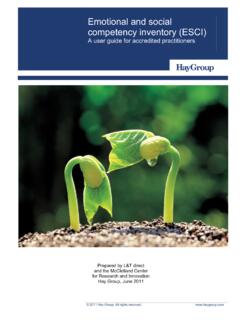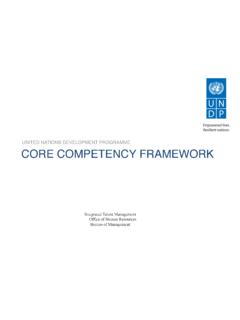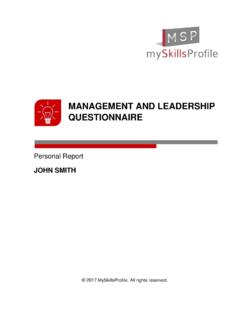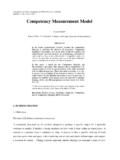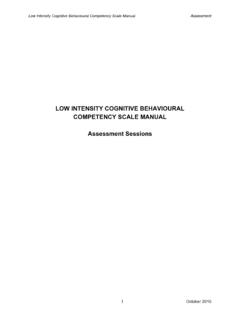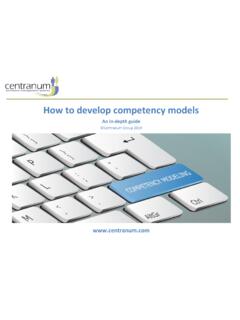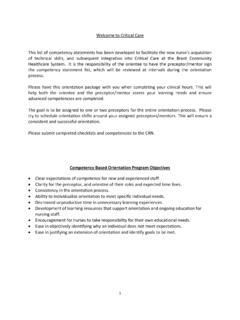Transcription of EXAMPLE WORKPLACE COMPETENCIES ADAPTABILITY
1 EXAMPLE WORKPLACE COMPETENCIES ADAPTABILITY Changes behavioural style or method of approach when necessary to achieve a goal; adjusts style as appropriate to the needs of the situation. Responds to change with a positive attitude and a willingness to learn new ways to accomplish work activities and objectives. Behavioural Indicators: Looks for ways to make changes work rather than only identifying why change will not work. Adapts to change quickly and easily. Makes suggestions for increasing the effectiveness of changes. Shows willingness to learn new methods, procedures, or techniques Shifts strategy or approach in response to the demands of a situation. ATTENTION TO DETAIL Thoroughness in accomplishing a task through concern for all the areas involved, no matter how small.
2 Monitors and checks work or information and plans and organizes time and resources efficiently. Behavioural Indicators: Double-checks the accuracy of information and work product to provide accurate and consistent work. Provides information on a timely basis and in a usable form to others who need to act on it. Carefully monitors the details and quality of own and others' work. Expresses concern that things be done right, thoroughly, or precisely. Completes all work according to procedures and standards. CORPERATE CARING Demonstrates responsibility for the image and effectiveness of the organisation or institution they currently or have represented Behavioural Indicators: Helps and supports fellow colleagues in their work to contribute to the overall success of the organisation or institution.
3 Works beyond the minimum job requirements and does whatever is necessary to get the job done. Uses all resources, such as equipment, paper, supplies, materials, etc., with the same care and efficiency as one's own possessions. Demonstrates clear awareness of the issues facing the organisation and its corporate objectives. Confronts potentially unethical behaviour, reports indiscretions appropriately. COLLABORATION Develops cooperation and teamwork while participating in a group, working toward solutions which generally benefit all involved parties. Behavioural Indicators: Demonstrates respect for the opinions of others. Identifies and pushes for solutions in which all parties can benefit.
4 Helps and supports fellow colleagues in their work to contribute to overall success. Keeps people informed and up-to-date. Shares information and own expertise with others to enable them to accomplish group goals. COMMUNICATION: OPEN Creates an atmosphere in which timely and high-quality information flows smoothly to colleagues at all levels , within or external of the organisation; encourages open expression of ideas and opinions. Behavioural Indicators: Asks open-ended questions that encourage others to give their points-of-view and is approachable at all times. Keeps relevant people accurately informed and up-to-date of both positive and potentially negative information. Appropriately expresses one's own opinion.
5 Refrains from immediate judgment and criticism of others' ideas delivers criticism in a way that demonstrates sensitivity to the feelings of others and waits for others to finish their intended message before responding. Encourages response and dissent to ideas and issues. COMMUNICATION: ORAL & WRITTEN Effectively transfers thoughts and expresses ideas orally or verbally in individual or group situations. Behavioural Indicators: Presents oneself clearly and articulately when speaking with an individual or before a group assuring that others fully comprehend the intended message. Checks for understanding of the communication by asking open-ended questions that draw out the listener(s) understanding.
6 Effectively uses appropriate literature or visual aids during product/service demonstrations or when giving presentations. Thinks through material for presentations in advance and organizes presentations in a logical flow. Repeats message back to speaker in a way that it is clear that the message is understood. CONTINUOUS LEARNING Demonstrates eagerness to acquire necessary technical knowledge, skills, and judgment to accomplish a result or to serve a customer's needs effectively. Has desire and drive to acquire knowledge and skills necessary to perform job more effectively. Behavioural Indicators: Keeps up-to-date on current research and technology in one's work focus and identifies and pursues areas for development and training that will enhance job performance.
7 Takes responsibility for one's own development. Maintains fluency in appropriate work applications, software, or tools. Reviews, selects, and disseminates information regarding key technologies, best practices, and tools to others in the group. Continually looks for ways to expand job capabilities WORK UNDER PRESSURE Understands their priorities and time-scales and works with a sense of urgency to meet deadlines. Performs jobs in an organised manner whilst maintaining their usual high standard of work that minimizes hazards to oneself, others, and the environment. Behavioural Indicators: Knows their timelines and whether or not this is achievable. Is able to work at a higher level, be it quality or speed without having a significant impact of performance.
8 Able to identify when they need support to achieve goals Can consistently re-asses priorities workload and act and communicate accordingly to achieve the desired result DISCERNMENT /JUDGMENT Makes decisions authoritatively and wisely, after adequately contemplating various available courses of action. Behavioural Indicators: Considers alternative available actions, resources, and constraints before selecting a method for accomplishing a task or project. Refrains from "jumping to conclusions" based on no, or minimal, evidence; takes time to collect facts before decision-making. Considers cost and efficiency when making decisions establishing or changing work procedures. Considers the long-term as well as immediate short-term outcomes and actions.
9 Appropriately balances needs and desires with available resources and constraints. Recognizes when to escalate appropriate or specific situations to the next higher level of expertise. DIVERSITY Supports and promotes an environment that holds opportunities for all, regardless of race, gender, culture, and age. Behavioural Indicators: Enthusiastically works with all employees at all levels , capitalizing on their strengths. Actively seeks opinions and ideas from people of varied background and experiences to improve decisions. Values and incorporates contributions of people from diverse backgrounds. Seeks information from many different sources before deciding on own approach. Demonstrates respect for opinions and ideas of others.
10 DRIVE FOR RESULTS Demonstrates concern for achieving or surpassing results against an internal or external standard of excellence. Shows a passion for improving the delivery of services with a commitment to continuous improvement. Behavioural Indicators: Recognizes and capitalizes on opportunities. Sets and maintains high performance standards for self and others that support their organisations strategic plan and holds self and other team members accountable for achieving results. Tries new things to reach challenging goals and persists until personal and team goals are achieved and commitments met. Works to meet individual and corporate goals with positive regard, acknowledgment of, and cooperation with the achievement of others' goals.

